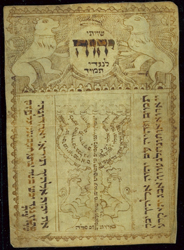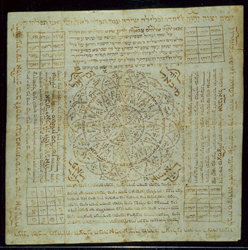
Shiviti Amulet
On vellum. Ca. 18th C. Unknown origin.
Shiviti is the opening word, in Hebrew, of the verse from Psalms 16:8 "I have set the Lord always before me." The verse-- included in the daily prayer-- was often written on votive tablets to be hung in synagogues in order to exhort worshipers to greater faith. The verse also appeared on amulets-- like this one-- meant to protect the owner from harm. The most common motifs of ornamentation for both the synagogue plaques and the amulets were the seven branched candelabra (a major symbol in Jewish iconography), representations of the holy places in Israel, animals or mythical beasts and persons. The lion was the commonly used animal and always appears in pairs. This amulet also includes statements in large block Hebrew characters regarding devotion to God.

Amulet
On vellum. Ca. 18th C. Unknown origin.
Meant to keep away the "evil eye" and misfortune, amulets were either worn on one's person or hung in one's home. This amulet was presumably meant to be hung in the home. Though frowned upon by many rabbis over the centuries, the pull of amulets, known in Hebrew as kam 'ot, was such that they were prevalent in most Jewish communities around the world. The illuminations on amulets are usually considered to be efficacious in warding off natural disasters, sicknes, violence, and other aflictions. They include the hexagram (six pointed star), the menorah (candelabra), and the hamsah (outreached hand).
This amulet (left) includes the names of the angels Michael, Gabriel, Raphael, and Uriel in each corner and prayers for protection from the many dangers that threaten life such as childbirth, fire and water. What is of particular interest is that it also contains a special prayer for the protection of love and lovers addressed to the angel Ahavi'el (loosely translated as God is my beloved).